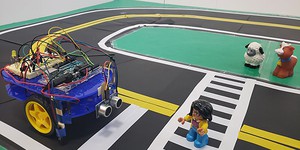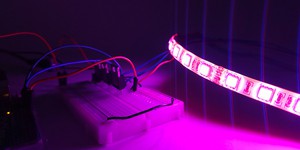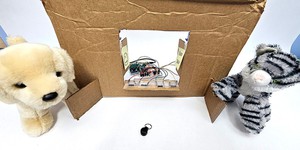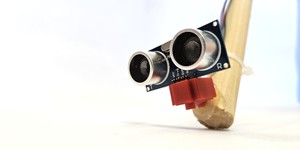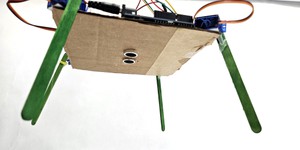HC-SR04 Ultrasonic Distance Sensor and Arduino (Lesson #9)
Want to learn more? Check out these other resources:
How do self-driving cars stay on the road? How do vehicles with autonomous or driver-assist features automatically brake, steer around obstacles, or perform tasks like adaptive cruise control? Experiment with these behaviors and more in this science project as you build and program your own autonomous Arduino robot.
Read more
Self-driving cars use a variety of sensors to evaluate and navigate their environment. Each type of sensor has advantages and disadvantages. In this project you will evaluate two common types of distance sensor (ultrasonic and infrared) and compare their performance in different scenarios.
Read more
Have you ever had lights turn on automatically when you walked into a room? Have you turned on a light with your voice instead of a switch? Maybe you have even seen lights that change color depending on temperature, ambient sounds, or how close you are to something. In this project you will design and build your own smart LED lighting system that can change colors and react to various things in the room. The possibilities are endless! Check out this page for more LED science projects.
Read more
Does your home have any pet doors or gates for dogs, cats, or other animals? Some automatic pet doors can be set up to allow only certain animals through. These doors can help you control which pets are able to go outside alone or which ones have access to specific food, litter boxes, or toys. But why buy such a door when you can make one? In this project you will build your own automatic pet door that works with a magnetic collar tag. Exactly how you use it is up to you!
Read more
Many individuals who are blind or visually impaired use canes to navigate their surroundings, using their sense of touch to detect obstacles. What if you could create an electronic cane that emits an audible warning before coming into contact with an object? This project allows you to do just that by incorporating an ultrasonic distance sensor and a buzzer to alert the user of approaching obstacles. You can customize the cane by adding additional features or altering the design, such as using a…
Read more
Many visually impaired people use canes to detect obstacles at ground level. What about detecting an obstacle at face level, like a tree branch? What if you need to keep both your hands free and cannot hold a cane? Solve both problems at once with these obstacle-detecting glasses! The glasses use an ultrasonic sensor to measure distance and a buzzer to alert the user of nearby objects. You can customize the design to add or swap out features, like using a vibration motor instead of a buzzer.…
Read more
Imagine that you need to make sure valuable cargo — like a robot or even human astronauts — can land safely on Mars. How would you do it? In this project, you will build your own model planetary lander using an Arduino. It will use a distance sensor and automatically deploy landing gear before impact. Can you avoid a crash landing?
Read more


